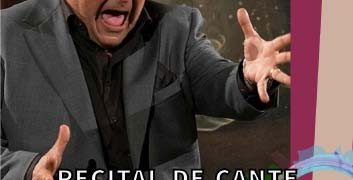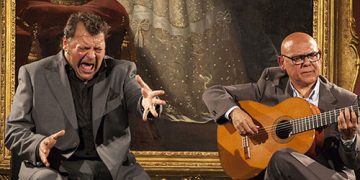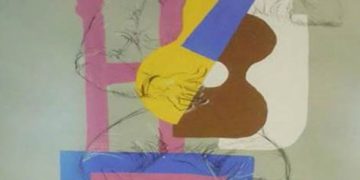|
SPECIAL REPORT: Text and color photos: Estela Zatania On October 22nd and 23rd, Friday and Saturday, the flamenco community of Jerez de la Frontera was in full celebration in honor of one of its best-loved singers. Gregorio Manuel Fernández Vargas, “El Borrico”, was born in the Santiago neighborhood of Jerez a hundred years ago, and you can be sure that while alive he could not possibly have imagined this kind of recognition three decades after his passing in 1983. When the curtain went up Friday afternoon at the Villamarta Theater, the wooden table, the bottle of wine and the men seated round tell us we’re at a typical Jerez tavern. In Jerez, everything begins and ends with the wooden table. Knuckles marking out the rhythm, cantes treasured like family heirlooms and finely-aged voices to give them life. Because a cante is nothing more than dead notes until the personality, life experiences and knowledge of a singer come into play. Borrico had generous amounts of all those elements. With his warm time-worn voice, and a certain innocence of spirit, he caressed the cante without being histrionic, opening the tap of the kind of flamenco that hurts so good and which all flamenco fans thrive on. Forty years ago, we paid paid far too little attention to his man of the country who one day discovered his ability, not only to communicate emotion, but to generate income with the cante that came so naturally to him as breathing. In his book “Tío Gregorio, ‘Borrico de Jerez; Recuerdos de Infancia y Juventud’”, José Luis Ortiz Nuevo quotes the singer’s own words: “…I told my mother I was going to a baptism and went to a little club there was in Cuatro Caminos which was called La Espiga de Oro, and that night everything was great, they introduced me to some rich guys, and to the young ladies who worked at the cabaret, one of them introduced me to another, and then another…between one thing and another I made more that night than in a whole year working in the fields, because I remember well, don Manuel Balcels gave me 500 pesetas to sing soleá and siguiriya”. In that precise moment, the young man became, for all practical purposes, a professional singer, although throughout his life he ventured little from his beloved Jerez where he was so happy with so little. Now, with the benefit of hindsight, we are able to see that this simple man with the permanently mournful voice worn to just the right degree, was one of the most important transmitters of cante from an earlier era that was in him by virtue of his family and surroundings. When Tío Borrico died, we were in full thrall of Camarón, and the first domestic computers were beginning to circulate. ESPECTÁCULO EN EL TEATRO VILLAMARTA Cante: Capullo de Jerez, Juan Moneo “El Torta”, Luis “El Zambo”, Juana la del Pipa, Juanillorro. Guitar: Periquín “Niño Jero”, Manuel Parrilla. Palmas: Gregorio, Chícharo. Narrator: Luis de Pacote. Directed by: José Ma. Castaño, Alfredo Benítez, Gonzalo López. The show “100 Años de Tío Gregorio ‘El Borrico’” included in the series Flamenco Viene del Sur organized by the Agencia Andaluza del Flamenco with the collaboration of the BBK bank, is a well-deserved straight-forward tribute to the life and work of the singer. At one small table, Luis de Pacote gives some informal information about the life of Borrico in between cante interpretations that take place at another table at the opposite end of the stage, in another “tabanco”.
Young singer Juanillorro, the least known of the cast, reproduces the repertoire and delivery of Tío Gregorio por tangos, and was the person who best conjured up the cantaor’s presence. Where lies the frontier between evocation and imitation? Impossible to say, but in this tribute recital, Juanillorro’s singing was a welcome touch. In bulerías, it was more of the same with Manuel Parrilla on guitar with his contemporary style and pure Jerez sound. Luis Zambo used his rich sincere cante to give us bulería por soleá, “bulería pa’escuchar” as it’s known here in Jerez, a much misunderstood label outside of Jerez. Martinete and bulerías completed Zambo’s contribution, followed by Juana la del Pipa who put her unique voice at the service of more bulería pa’ escuchar and bulerías in honor of Tío Borrico, while images of the legendary bar Volapié, point of encounter of several generations of Jerez singers, were projected on the backdrop. The aroma of wine-cellars and sherry, the cruel sting of want assuaged by cante, Jerez of the frontera of the mind, where memories weigh more than reality and the imaginary has a life of its own. Torta, cult figure, sang alegrías and bulerías with Periquín on guitar, and the audience, though not packing the house, was enthusiastic. Hours earlier a representative of the theater had commented that “in Jerez, flamenco doesn’t fill seats until the foreigners come for the dance festival”. Interesting piece of information. Capullo was on last, for some inexplicable reason assigned the task of siguiriyas when there were more appropriate singers available, and he also sang his signature bulerías. We’d been missing a little warmth throughout this sentimental tribute, but the cante of one of Borrico’s grandsons, with the flavor of his grandfather’s singing, was the nostalgic icing on cake. The whole thing ended with a brief segment from the series Rito y Geografía del Cante in which we could once again savor Borrico’s singing and dancing.
ROUNDTABLE DISCUSSION AND BOOK PRESENTATION
Guitarist Paco Cepero remembered how Pedro Peña and his brother Lebrijano used to go to Jerez when they were young whenever they had a little bit of money to listen to Tío Borrico who, according to Cepero, “taught many people to sing”. Investigator Ramón Soler pointed out the importance of oral transmission as a way of learning flamenco singing, and his recreation of Cádiz cante to which Borrico gave an unmistakable Jerez twist. Shortly afterwards, at the Antonio Chacón flamenco club, the book/CD “Cien Años de Tío Gregorio El Borrico”, the work of José María Castaño with the collaboration of Alfredo Benítez and Gonzalo López and which includes biographical data, commentary, photos and previously unpublished recordings.
|
Descubre más desde Revista DeFlamenco.com
Suscríbete y recibe las últimas entradas en tu correo electrónico.































